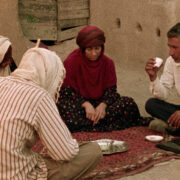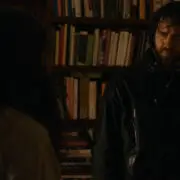Anarchic Cinema: V-Cinema & Takashi Miike
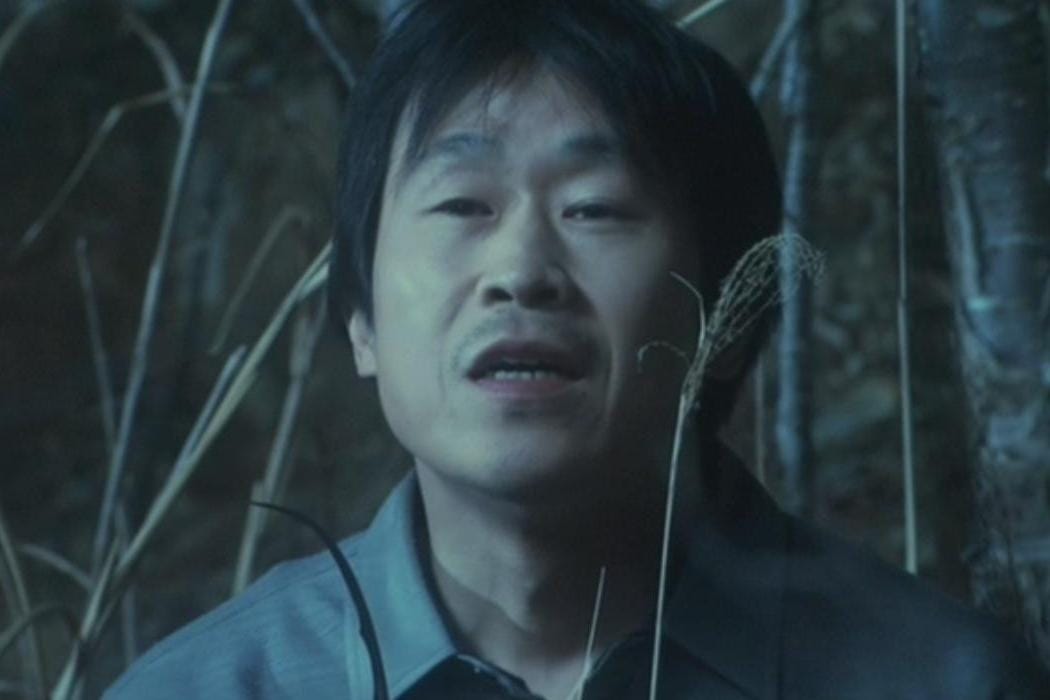
Matthew Roe is a director, writer, producer, film critic, theorist…
In the 1980s, the world was engulfed in the VHS and Betamax boom, allowing for the first time the widespread purchase and use of commercial-grade video equipment by the public-at-large. This, in turn, opened a brand new market to low-budget filmmakers to produce and distribute their works without major studio interference or management, and being able to surpass the normal avenues of distribution.
Being propelled by fierce advertising campaigns and word-of-mouth, this technological innovation effectively launched the DIY Independent Movement of the 1990s. There has been heated industry debate since the movement’s inception as to what now stands for quality filmmaking, mainly referencing the avalanche of low-grade schlockfests and pornography that made up the bulk of the United States VHS market.
However, this newer industry carried a interestingly different connotation in Japan, where it ignited an explosive wave of creativity and ingenuity that still carries a significant portion of Japanese filmmaking to this day.
The Birth of Original Video/V-Cinema
This market came to be known in the West as Original Video (or V-Cinema); and while there are legions of critics, fans and filmmakers in the United States who have historically declared direct-to-video productions are not worth much investment (besides a handful of outliers), many Original Video directors are responsible for deeply significant strides in evolving and breaking our conceptions of what modern film is, and how it can be used.
This deluge, however, was not born in a vacuum. While absolutely inspired by the arrival of this new tech, the young movie punks of the day became driven by the creative freedom and lesser censorship afforded this production and distribution method, and since the mainstream Japanese industry was suffering record lows in nationwide audience attendance, it seemed that in late-80s Japan, the filmmakers and audiences had begun to lose touch with one another. This is where that changed.
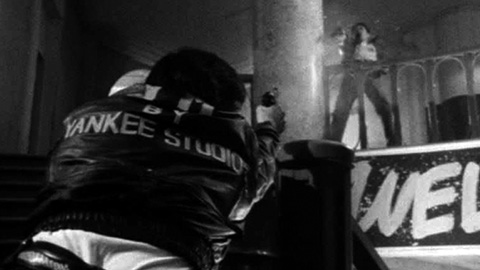
That isn’t to say that masterful films (in Japan, and the world over) were not created by mainstream producers during this period, or that Original Video didn’t heap mountains of filmic trash fires onto the public to rival the US, but that this stagnation allowed for some of of the world’s most aggressively prospective new talents to be discovered and to flourish.
Ironically enough, however, this new movement of innovators and redefiners actually began at one of Japan’s Big Four film studios: Toei. According to Midnight Eye, after Toshimichi Okawa’s Crime Hunter (original title: Kuraimuhanta Ikari no Judan) became a runaway success as the first part of Toei’s V-Cinema block in 1989, “the format was adopted by other film companies as a means for producing and releasing live-action features.
By the end of 1991, all the major players in film distribution, and a good number of minor ones too, had their own line-up of made-for-video product, under imprints like V-Feature (Nikkatsu), V-Movie (Japan Home Video) and V-Picture (VIP).”
Crime Hunter’s content, aesthetic and sublime marketing gimmicks by producer Tatsu Yoshida, subsequently invented a raw new market defined by low-grade genre movies (imagine if American International Pictures existed, and was in their prime, in the 1990s). To be clear, Original Video productions were already in use since the early 1980s, as a means to distribute anime productions (known as Original Video Animations, or OVAs).
But this blend of technological evolution, and a wide desire for riskier content that most of the major production houses would not normally touch, produced a swell of rapid-fire gonzo filmmaking that would come to define the entire attitude of 1990s independent world cinema.
So Who’s The New Punk?
While I cannot vouch (obviously) that Thomas Vinterberg or Lars von Trier had (or have at all) seen any V-Cinema releases, it’s hard to deny that there was a thematic and technical correlation between both groups. However, while Dogme 95 sought to redefine the way film was to be approached within the context of the existing industry and exhibition market, V-Cinema was throwing out all traditional convention and making up rules on the fly.
This is the freedom and accessibility that the No Wave and Transgressive filmmakers could only dream about in the late 1970s. As a result, Japanese Original Video productions were far more embraced in Europe and the United States throughout the 1990s, as it more accurately reflected the social and cultural upheavals of the era. One of these films destined for video store shelves, which would catapult its cast and crew into stardom, was the 1996 Original Video, Fudoh: The New Generation (original title: Gokudo Sengokushi Fudo).
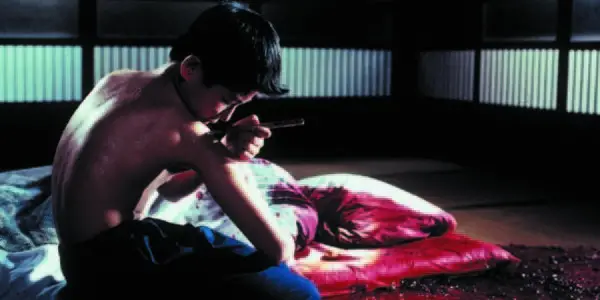
This work was the collaboration of three men: screenwriter Toshiyuki Morioka, producer Yoshinori Chiba, and the star of this installment, director Takashi Miike. After Chiba saw the rushes of the film, he was so inspired to release it theatrically, that he managed to secure Fudoh a 35mm blow-up, and foreign film festivals soon got wind of this crazy movie in which a mob boss murders one of his own sons, and then is sworn vengeance upon by his other son and his gang of teenage murderers.
It became a significant festival darling, playing at at the Brussels Fantastic Film Festival, Fantasia Film Festival, Toronto International Film Festival, and even winning the International Fantasy Film Special Jury Award and the Fantasia Section Award at Fantasporto. While there are many contributors to Japanese Original Video that deserve a shout out, and many would receive theatrical releases of their own, Miike essentially became the poster boy for this new movement, and is arguably one of the most prominent and prolific directors still working in the medium today.
Now, remember where we’ve walked to get to this point (take a look at previous installments, if you have not). Though each installment of Anarchic Cinema will not always focus on a form of nihilistic filmmaking, such approaches are crucial elements to understand the core of this particular film theory. Warhol Film was relaxed passive nihilism, Transgressive Cinema was unabated aggressive nihilism, and Dogme 95 was overly-structured naturalistic nihilism. Miike took filmmaking in another direction: industrial nihilism.
Miike is famously known for believing that directing and creating films as a whole is not an art form, and is not something that should be appreciated or pedestaled more than any other job. He, of course was not the first to think along these lines (others include John Ford), but denying the art of film itself while contributing some of the best contemporary examples of an evolving medium produces a highly conflicted stance.
As his international fame has grown exponentially since his subsequent breakout hits Audition (1999) and Ichi the Killer (2001) to being one of the most premier and in-demand Japanese directors, his consistency is remarkably… well, consistent. The overall quality of his style may have evolved in small ways, but his attitude has remained constant since he started directing Original Video works in 1991. Even if you do not care particularly for Miike’s films, that fact is fairly impressive and commendable.
So How Is Takashi Miike Anarchic?
Anarchy (to reiterate and paraphrase), is the focus of individualized self-governance and self-reliance. In cinema, this can often take the form of nihilism on screen, thus projecting the intent of the filmmaker onto the audience through content. Miike, rather than using cinematic devices to emblemize his concepts for an audience, uses the process itself to explore and experiment.
Dogme tried to express this through restrictions (such as forbidding of directorial credit, optical effects, and tripods), but many filmmakers either bent or would break these rules quite liberally during the movement’s existence. These laxes in the Vow of Chastity often would strike heated debate within the movement when trying to consider a film as a valid entry into the movement, eventually (I believe) leading to severe participation burnout.
However, even before Dogme’s inception, Miike (and likewise V-Cinema) was stripping away this vast artistic ego, because it unnecessarily weighed down the process.
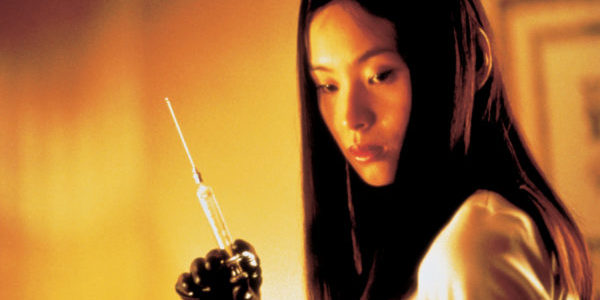
Takashi Miike said, in an interview with Daniel Robert Epstein (published in SuicideGirls), “I don’t try to keep things balanced. That is the way I am and since this work comes from me, it ends up like that.” While that was in response to a question regarding his film Gozu (2003), it honestly is the best summation (in his own words) of his whole body of work. Take two of the films I have previously mentioned: Fudoh and Audition, and we’ll add another for discussion and contrast, The Happiness of the Katakuris (2001). Each film, though similar in many thematic and contextual aspects, also are vastly different exercises in cinematic manipulation.
Fudoh is defined by its absolutely demented violence, and subverting ideals surrounding youthful innocence. While this thematic combination isn’t new (just check out Nobuhiko Obayashi’s House, 1977), and Miike would use these through-lines in many other works, his freeform technique allowed for the utter chaos of the world and story to take full shape.
The provocation of this work is less its torrents of blood and taboo sexualization, and more for its ambiguous exploration of a broken family, and how much apparent fun the film is having while doing so. Employing colour schemes, lighting techniques, and camera movements that would make Dario Argento wince, the film is naturally inclined toward offending and provoking audiences of all kinds; no one is exempt.
Though this film may appear to be the most “anarchic” of all of Miike’s works I am covering here, it actually has the least amount of technical experimentation. This was a director discovering what he was good at, how he can become more proficient, and that no one was going to rein him in from doing what he wanted and how he wanted to do it (Fudoh’s main elements would come to perforate almost all of Miike’s most notable works from this point forward).
Audition was Miike’s first technical exercise in (what I call) ‘boredom and shock.’ For the vast majority of this movie, it seems to aimlessly follows its characters doing very little, and saying even less. This lulls audiences into a false sense of expectation, and eventually becomes quite possibly the best bait-and-switch of Miike’s entire career (as well as screenwriter Daisuke Tengan).
The final act of the movie goes through such extremes (spurred on by crisscrossing genre cliches and gore), the whole experience becomes a giant middle finger to conventional tension building, story structure and visual conveyance. Takashi Miike did everything that film schools say not to do when making a horror film, and ended up making one of the most quintessential horror films of the 20th Century (and he doesn’t even personally consider Audition a horror movie).
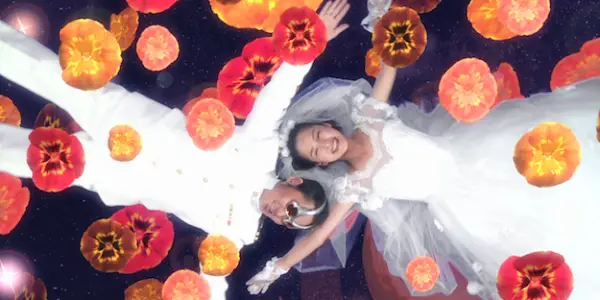
Finally, The Happiness of the Katakuris is (by far) the most technically insane film of Miike’s filmography, and was his first musical. Loosely based on Kim Jee-woon’s The Quiet Family, and often credited as “The Sound of Music meeting Dawn of the Dead” this feature is a roller coaster fever dream consisting of (as described by its UK tagline) “love, music, horror, [and] volcanos” and was made in the same year as his more widely-lauded work, Ichi the Killer (as well as six other features).
Throughout the rough-and-tumble song and dance routines hallmarked by bug-eyed overacting, sinisterly dark humor, and constant gross-outs, genres and mediums blend and blur into an indistinguishable (and beautiful) mess. The claymation sequence alone is worth the investment in watching this film, as it is so starkly different than every other segment and is just as batty. This hybridization of themes, techniques and tones feels reminiscent of Trey Parker’s Cannibal! The Musical (1993) meeting Ken Russell’s Lisztomania (1975); exploitive violence meeting musical movie madness.
There isn’t a solitary other film in existence (that I am aware of) that is at all like this production, it almost defies all categorization or description.
Conclusion
Now known for helming high-profile theatrical releases each year, Takashi Miike has remained an active champion of the Japanese Original Video market to this day, and some of his later V-Cinema entries (such as Visitor Q and Waru) are still considered some of the better and more inventive entries into the market. Miike was quoted in saying in an 2001 interview with Midnight Eye, that while directing, “the minimum requirement [is] that you enjoy yourself.” Miike is the living embodiment of his own philosophy; his filmic tactics nixing the standard requirements for genre, plotting, and even (sometimes) coherence, and never concerning himself with things like artistic integrity and auteur theory. He’s here to make movies, he does a damn good job at it, and that’s all there is.
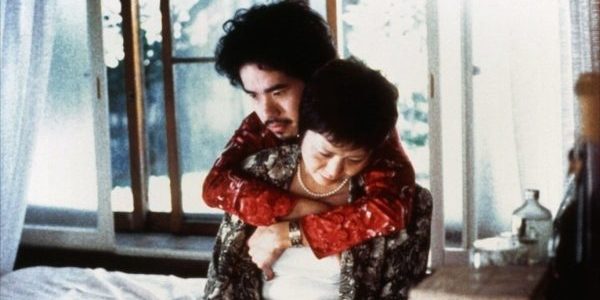
As we’ve said before, because anarchy in art can tend to be an abstruse concept, there are many avenues in which it can be achieved. While allegorical representations of these ideals have been the most common up to this point, we need to observe and dissect each facet of filmmaking to understand the full scope of what this theory constitutes. While filmmakers like Andy Warhol and Nick Zedd had their theoretical ideals bleed over into the technological factors of their work, Takashi Miike allowed the exact opposite to occur, and thusly had a far greater impact on worldwide modernizations and explorations in moviemaking. That’s Anarchic Cinema.
What are your thoughts on Takashi Miike and the V-Cinema/Original Video Movement?
Does content like this matter to you?
Become a Member and support film journalism. Unlock access to all of Film Inquiry`s great articles. Join a community of like-minded readers who are passionate about cinema - get access to our private members Network, give back to independent filmmakers, and more.
Matthew Roe is a director, writer, producer, film critic, theorist and historian, with over 12 years experience producing film, video, television, and online content. He currently writes DVD/Blu-ray reviews for Under the Radar Magazine, movie reviews for Film Threat, and contributes features to the Anime News Network. He has won two Vollie Television Awards, an Honorable Mention at the LA Movie Awards, and is a Cult Critic Award Finalist. Matthew is a member of the Political Film Society and the Large Association of Movie Blogs.







